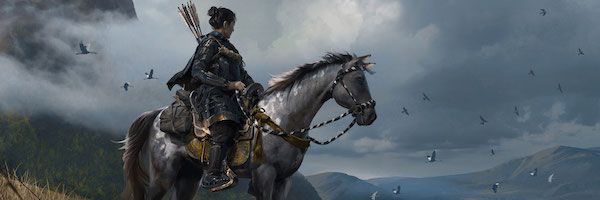There are two things you need to know about Ghost of Tsushima. (Well, okay, there are a ton of things you need to know, but that will have to wait for the embargo lift; stay tuned.) First of all, the title location where your samurai adventure plays out is based on a real-world location, which the Sucker Punch Productions team scouted extensively in order to recreate the island's natural beauty and climate in-game. Secondly, they did so in a variety of ways that make the game feel, at times, more cinematic than gamers might be used to. One of those ways includes Kurosawa Mode, a viewing experience that's not just a meme-y black-and-white filter with film grain, but one that has the blessing of the late, great filmmaker Akira Kurosawa's estate.
In EW's chat with the Sucker Punch team, including creative directors Jason Connell and Nate Fox, they discovered just how much work went into the unique and iconic gaming experience that became Kurosawa Mode. There are the film references, of course, notably Sanjuro (1962) and Seven Samurai (1954), but even more importantly, there's the attention to detail that results in a much more subtle "mode" than a simple filter, as Connell explains:
"We actually did some research on the curves that may have existed on that kind of film that [Kurosawa] might've used."
"How deep were the blacks? How bright were the whites?"
Additionally, since sound is very important in the game:
"We actually toyed with the audio a little bit. Our audio team have an internal tool that mimicked sounds of old TV and, specifically, megaphones, radios, TVs back to the '50s."
The modernized lens of Kurosawa looks out onto the real-world location of the Japanese island of Tsushima, a place that was extensively explored by the Sucker Punch team. The game's Environment Art Lead, Joanna Wang, went into detail about their approach in a recent PlayStation blog post. Here's some of what you can expect to see and explore, in her words:
[O]ur version of Tsushima is not a 1:1 recreation of the real-life counterpart — it’s a love letter to all of its parts. We took essential elements of the island, mixed with some inspirations from mainland Japan, and built this unique world for Ghost. During our trips, we recorded birds and nature sounds and photo-scanned leaves from Tsushima island, and used them in the actual game. This was a way for us to bring a little piece of the real island of Tsushima to you.
Ghost of Tsushima is by far the biggest game we have ever made. The map is divided into three regions filled with more than forty diverse Biomes and hundreds of points of interest. Our goal when building an open world game is always “if you can see it, you can reach it.” You will journey through lush forests, cross boggy swamp lands, and enter into frozen mountainous landscapes. We collected so many references from movies, games, paintings, and even travel posters to draw inspiration. We want to present you with an authentic, believable world, a world that would call out to you, inviting you to explore, a world that is rich and full of surprises.
The world of Tsushima is built around two pillars: natural beauty and manmade order. While exploring the world, you may follow a string of torii gates to a forgotten shrine, assault a fortified castle, or find an abandoned fishing hut near the water. There are hundreds of locations in Tsushima to explore and hidden rewards to find. Based on the region, different locations have their own identity. For example, the healing town of Akashima is located in lowland wetlands. Moss hangs and grows on every surface, mist lingers above the ground, and incense burns near the great bell. You might even hear frogs croaking around you. It is mysterious and beautiful.
"Mysterious and beautiful" is where we'll leave the exploration of Ghost of Tsushima for today, but be sure to head to the links above for much more on Kurosawa Mode and the gorgeous environments that await you when the game arrives on Friday, July 17th.

